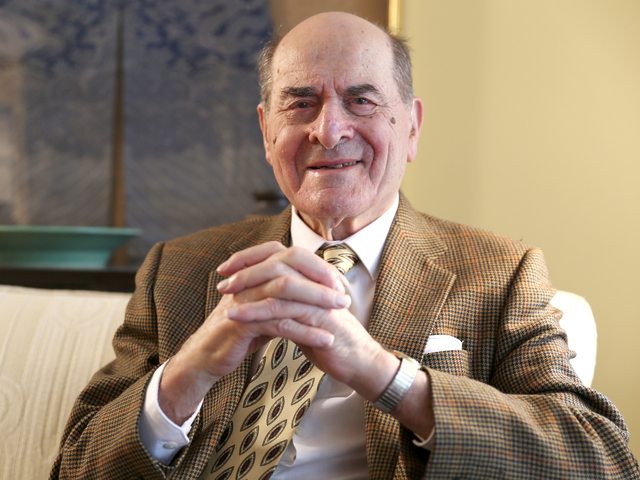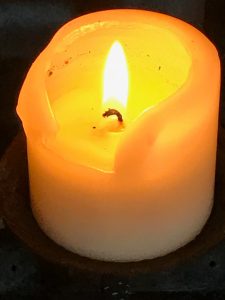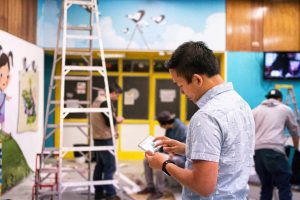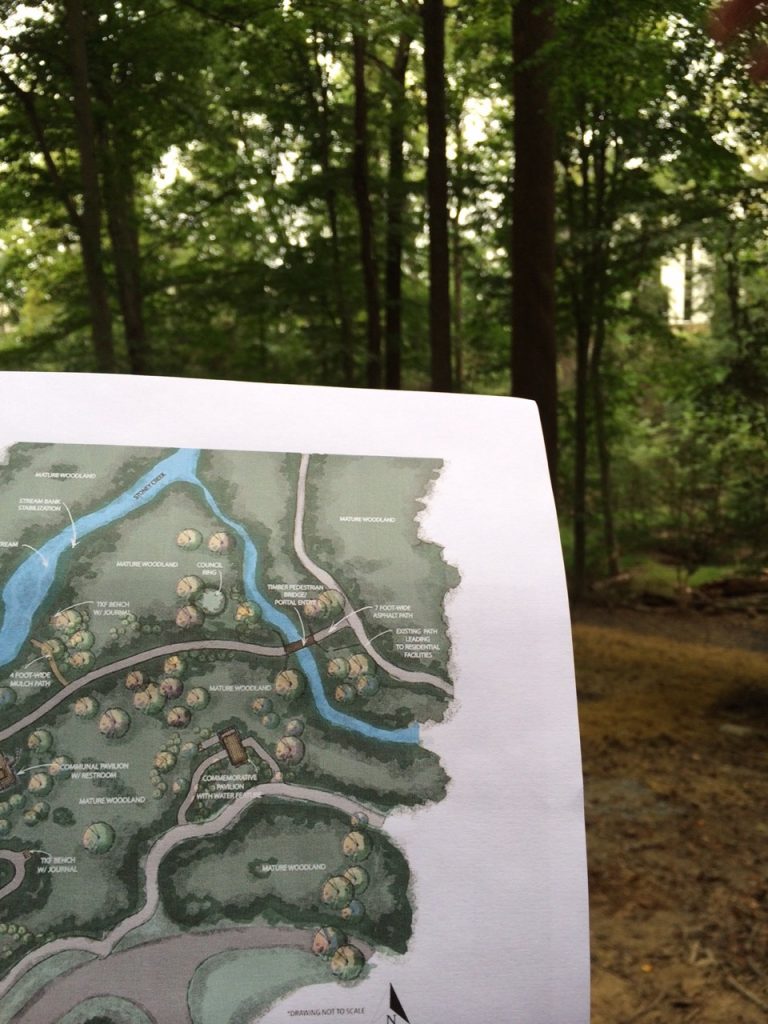Author Archive
Office of the Future?
 Judging by the media attention, our recent British Medical Journal: Occupational Environmental Medicine study (Casey Lindberg et al. & GSA’s “Wellbuilt for Wellbeing” Team, 2018) clearly struck a chord. It seems that workers – at least those who commented online, viscerally hate their open office settings. But what we found, using objective measures collected from wearable devices, was that office workers in open office settings were 32% more active than those in private offices, 20% more active than those in cubicles, and the more active workers were less stressed during after work hours. Such differences, especially when cumulative over a working lifetime, are well within the medically relevant range. A 2018 report summarizing ten studies’ research findings of more than 17,000 people (American Journal of Preventive Medicine) found that simply replacing 30 minutes of sedentary activity daily with 30 minutes of even mild activity significantly reduced BMI (Body Mass Index = weight/height), risk of diabetes, cardiovascular disease and all-cause mortality. Imagine – your office could be part of your daily exercise regime – without any effort at all on your part. And yet people complain of noise, distraction, feeling watched. Indeed, other studies using different measures have reported negative effects (Philosophical Transacations of the Royal Society B). The open offices we studied were designed purposefully to give workers many choices for different kinds of work activities, including quiet areas for individuals, private conversations or small meetings. Although, without more research, we won’t know the reasons, it may be that people in the open offices moved more in order to get to those different spaces. We are entering a new era, where fewer people need to go to an office to work. More are telecommuting, working from home, or wherever they happen to be – coffee shops, the beach. Indeed, at an upcoming summit “RETHINK: Office of the Future: New York“, where I will be speaking, building owners and industry leaders will be grappling with how to design offices to adapt and stay ahead of the times. So, employers, if you want to keep your workers healthy, work with experts to get the objective measures you need to design your offices thoughtfully. In the meantime, workers, you can think of your office as your new gym!
Judging by the media attention, our recent British Medical Journal: Occupational Environmental Medicine study (Casey Lindberg et al. & GSA’s “Wellbuilt for Wellbeing” Team, 2018) clearly struck a chord. It seems that workers – at least those who commented online, viscerally hate their open office settings. But what we found, using objective measures collected from wearable devices, was that office workers in open office settings were 32% more active than those in private offices, 20% more active than those in cubicles, and the more active workers were less stressed during after work hours. Such differences, especially when cumulative over a working lifetime, are well within the medically relevant range. A 2018 report summarizing ten studies’ research findings of more than 17,000 people (American Journal of Preventive Medicine) found that simply replacing 30 minutes of sedentary activity daily with 30 minutes of even mild activity significantly reduced BMI (Body Mass Index = weight/height), risk of diabetes, cardiovascular disease and all-cause mortality. Imagine – your office could be part of your daily exercise regime – without any effort at all on your part. And yet people complain of noise, distraction, feeling watched. Indeed, other studies using different measures have reported negative effects (Philosophical Transacations of the Royal Society B). The open offices we studied were designed purposefully to give workers many choices for different kinds of work activities, including quiet areas for individuals, private conversations or small meetings. Although, without more research, we won’t know the reasons, it may be that people in the open offices moved more in order to get to those different spaces. We are entering a new era, where fewer people need to go to an office to work. More are telecommuting, working from home, or wherever they happen to be – coffee shops, the beach. Indeed, at an upcoming summit “RETHINK: Office of the Future: New York“, where I will be speaking, building owners and industry leaders will be grappling with how to design offices to adapt and stay ahead of the times. So, employers, if you want to keep your workers healthy, work with experts to get the objective measures you need to design your offices thoughtfully. In the meantime, workers, you can think of your office as your new gym!Life Saving Part 2
After my talk, we sat around the table, as I caught up on dinner. I recounted the time in the mid-nineties when I had met Dr. Heimlich at a reception on Capitol Hill. When my host pointed him out to me at the reception, and asked if I wanted to meet him, I had responded “But I thought he was dead.” She said “No. He’s standing over there drinking a martini. Want me to introduce you?” I said of course. We walked over to a tall, elegant man, I estimated then in his late 70’s or 80’s. I asked him if he was really THE Dr. Heimlich. He said yes. Then I asked him how he had figured it out. He smiled, and put his arm around my waist in a fake Heimlich, and said: “By putting my arm around beautiful young women.” Some women had been offended when I told that story, so I stopped telling it. But he did it in such a charming and harmless fashion, that I wasn’t offended at all. I simply laughed and said “No really. How did you figure it out?” He then proceeded to tell me about the years of animal studies he had done as a cardiovascular thoracic surgeon, which led him to figure out the best way to dislodge an object from a choking person’s windpipe. He told me that, more meaningful to him than knowing the tens of thousands of lives that the maneuver had saved, was hearing the individual stories of individual people who had used it to save a loved one. I told him that I had used it on my daughter when she was three years old, when she was choking on a bit of carrot. That was the last time I had done the Heimlich on a real person, until last week when I used it again on my dear friend. How odd that performing a maneuver developed through years of painstaking research, could have brought about in me that ethereal sense of calm. On the one hand, I could explain it by the principles of the stress response. Because of my years of training, my stress response immediately kicked in and gave me the energy to focus my attention and get the job done. My host at the speaking event said as much to me when he observed: “You were like a Labrador – you just shot straight over” and performed the Heimlich. That was my stress response working for me. What about the sense of calm that set in? That was my “relaxation response” kicking in, to counter the stress response and shut it off when it was no longer needed. But I can’t help feeling that it was something more – something or someone watching over both my dear friend and me. We both felt it in the moment: a light, an energy, pouring in from above. When I recounted the story to my sister, she said: “Did you know that Dr. Heimlich just died recently?” [Link] I hadn’t heard. At some level I wonder if maybe Dr. Heimlich knows that I have used his maneuver once again to save a loved one.Life Saving Part 1
There are few moments when it is clear that one stands at the threshold between death and life. And there are even fewer when one has the privilege to be able to pull a life back across that threshold, or prevent it from going over. Even though I am a physician, I can count them on the fingers of one hand. Once, when I was a resident doctor running the emergency room in a small community hospital in Montreal, I decided to admit a young woman to hospital who had what seemed like a simple urinary tract infection. I never fully understood why I made that decision, rather than sending her home with antibiotics. But when her heart stopped beating while we were still completing the admission papers, I knew I had done the right thing. Because she was in hospital, we were able to resuscitate her and save her life. Had I sent her home she would have died on the street. It happened to me again one evening last week. I had been invited to be the dinner speaker at an event in Tucson, and was given the opportunity to invite a few friends. After everyone had filled their plates at the buffet and were settled back in their seats, the hosts began the introductions. I stood quietly off to the side, in front of the audience, waiting for my cue to take the center stage and start my talk. While the hosts spoke, I surveyed the room – about one hundred people at table rounds, with my friends clustered at two reserved tables directly in front of me. Behind them, through a windowed wall, I could see the stunning backdrop of the city lights of Tucson far below.I was reviewing in my head a new introduction to my talk, recounting how I came to do the research I am doing. I planned to describe that patient whose life I had saved long ago, because she figured centrally in that tale. Then the silence of the room was interrupted by a commotion at my guests’ table in front of me about twenty feet away. I couldn’t see exactly what was going on, but it seemed out of place, especially during the introductions. My significant other and a dear friend at the table both signaled to me to come over, and the host was moving quickly to the spot, even while she continued to hold the microphone in her hand. And then I saw it: another dear friend was slumped over in her seat, and those around were patting her back. I rushed over, slipped my arms around her waist, and gave her a quick yank. And then I gave another. Nothing happened. I wasn’t 100% sure she was choking and leaned in to ask her if she could talk – she shook her head no. I asked if she could breathe. She half turned to me and shook her head again. This time I could see the terrified look in her eyes; her face was pasty white and her lips were blue. I could hear the wheezing in her throat. I knew then that this was the real thing. It had been a long time since I had taken my CPR re-certification – almost five years before. While at NIH we had to be re-certified every two years, practicing resuscitation techniques on dummies, including the Heimlich maneuver to release the obstruction in a choking person’s throat. But, not seeing patients anymore, I hadn’t taken the course since moving to Arizona almost five years ago. When the first two tries didn’t work, I said to myself “I have got to make this work. I will never forgive myself if I can’t make it work.” I re-positioned my arms and grasped my hands together in a fist, this time scooping upwards with all my might. And then suddenly, my friend breathed in and started nodding her head, signaling that she was all right. I heaved a sigh of relief and hugged her close to me. An incredible sense of calm came over me, as if it was pouring into me from above. Then, almost as quickly as the whole event had unfolded, the host walked back to the stage and resumed her introduction. I moved back to my spot in front of the audience and again waited for my cue. I looked at my friend, asking silently if she was OK. She nodded yes and smiled. I blew her a kiss, gave her the thumbs up, and began my talk, still with that sense of calm. My friend had the last word in the question and answer period at the end of the talk. She took the microphone and said “Thank you for saving my life.” I held my hands out to her in a hug, and at some level, hard as it was to believe, I knew this was true. To be continued…Good Stress/Bad Stress and Good Relaxation/Bad Relaxation
You’ve heard of “good stress/bad stress,” right? [Link] We’re all probably feeling some of both now, in the holiday crunch.You’re feeling good stress when you are excited about getting together with loved ones, looking forward to sharing gifts, meals, and holiday traditions. Bad stress is feeling overwhelmed by it all, being pressed to get all those gifts bought, wrapped, and distributed in time, while at the same time preparing all that delicious food to serve to your guests, and getting the house in shape too.
The same parts of your brain cause both good and bad stress. The brain’s stress response turns on to give you the energy and focus to get all those things done – that’s the good stress bit. But when the stress response goes into overdrive for too long, that’s bad stress – and it can make you get sick.
What about relaxation – is there “good relaxation” and “bad relaxation”? I believe there is.
Harvard’s Dr. Herbert Benson coined the term the “relaxation response” to describe the brain’s way of countering the stress response. Just as there are brain pathways, hormones, and nerve chemicals that drive the stress response, there is a nerve pathway that underpins the relaxation response. It’s called the vagus nerve.
There are many ways to turn on the vagus nerve and the relaxation response. Most involve deep breathing: meditation, yoga, Tai Chi, gentle exercise, like walking, even prayer. Massage therapy and acupuncture can do it too. These all induce a deep, restorative kind of relaxation, which stops the stress response in its tracks. It’s as if you’re driving down the highway at 90 miles an hour, and you put on the brake – the gas pedal is the stress response and the brake is the relaxation response.
I call all these integrative, mind-body approaches to relaxation “good relaxation.”
But there is also what I call “bad relaxation,” most of which involve prolonged sitting, like couch-potato television viewing, or being glued to your computer screen for hours at a time. There is mounting evidence that prolonged sitting bouts and a sedentary life-style like these, are bad for your health.
So at this hectic time of year, take time out – even just a couple of minutes or so, for some “good relaxation,” especially when you feel like your good stress is turning into bad. Try to avoid “bad relaxation.” Turn off the computer and TV. Instead take a walk with friends, or go outside to toss a football, take a walk, or build a snowman. Or, if you can’t spare the time to relax, try one of Dr. Andrew Weil’s deep breathing exercises [Link] – they take hardly any time at all. You’ll block that bad stress response and shift the anxiety it causes back to where it gives you the energy to enjoy the holidays!
Sidewalk Poem
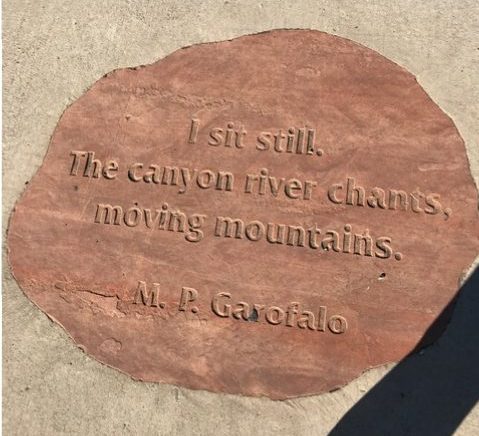 I came upon this poem, carved into the sidewalk in the most unlikely place – along a six-lane thoroughfare in the Tucson Foothills, overlooking the city and Tucson Mountains to the south, flanked by the Santa Catalina Mountains to the North. I have driven by this spot at least several times per week and sometimes more, from the day I moved to Tucson four and a half years ago. I mostly drive by, like all the other cars, at the speed limit of 45 mph. I slow down if I am turning into my bank’s parking lot at the corner, but I never noticed this poem until today. That’s because the only way to see this poem is to walk over it.
I came upon this poem, carved into the sidewalk in the most unlikely place – along a six-lane thoroughfare in the Tucson Foothills, overlooking the city and Tucson Mountains to the south, flanked by the Santa Catalina Mountains to the North. I have driven by this spot at least several times per week and sometimes more, from the day I moved to Tucson four and a half years ago. I mostly drive by, like all the other cars, at the speed limit of 45 mph. I slow down if I am turning into my bank’s parking lot at the corner, but I never noticed this poem until today. That’s because the only way to see this poem is to walk over it.Yesterday I was forced to walk over it because my car wouldn’t start. I had been rushing about doing holiday shopping and last minute errands, feeling good about myself as I checked off each item on my list. It was well past lunch time, and though hungry, I kept telling myself – just one more thing I need to get, just one more place I need to stop at – then I’ll go home. I had run out of cash so I decided to go to the bank to get cash out of the ATM. I drove into the parking lot, parked, dashed out to the ATM, got the cash, jumped back into the car, set to do just more thing on the list.
I turned the key in the ignition and heard a ticking sound. I turned it again – same thing; and again; and again – but no engine catch. I called my significant other, so he could listen. “Sounds like the battery or something electrical,” he said. “When did you last get a new battery?” I couldn’t remember. “Well, that’s a bad sign,” he said. “Call AAA.”
So I called AAA. They took all my information and said it would take an hour for the service person to arrive – enough time for me to walk across the street to the deli for a sandwich, and be back at the car waiting.
I felt irritated. So much more to do, and now I was stuck. But, then I thought, it was a beautiful, sunny afternoon, I was stopped in a beautiful place, I was safe – things could be a lot worse.
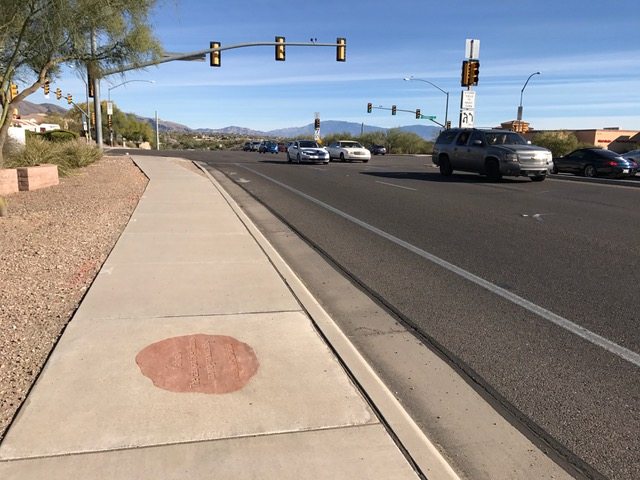 So I started out on my little adventure, heading along the sidewalk to the stoplights at the corner. Cars were whizzing by at top speed – daunting if you are walking along that stretch of road. And then I looked down, and saw the poem. I stopped, turned back and looked at it again.
So I started out on my little adventure, heading along the sidewalk to the stoplights at the corner. Cars were whizzing by at top speed – daunting if you are walking along that stretch of road. And then I looked down, and saw the poem. I stopped, turned back and looked at it again.
I sit still,
The Canyon river chants,
moving mountains.
M.P. Garofalo
 This is exactly what my car’s breaking down had forced me to do – sit still. I looked up at the mountains behind the bank, and I thought, how fortunate that my car wouldn’t start. I may never have noticed this poem for another four years, and what a loss that would have been.
This is exactly what my car’s breaking down had forced me to do – sit still. I looked up at the mountains behind the bank, and I thought, how fortunate that my car wouldn’t start. I may never have noticed this poem for another four years, and what a loss that would have been.
Sometimes you have to be forced to stop in order to think.
I wondered who M.P. Garofalo was. If you Google M.P. Garofalo the phrase “Concrete Poetry” comes up. It seems that concrete poetry is an accepted art form. Under the link to “Concrete Poems by Michael P. Garofalo,” you find the following definition:
“Just as concrete is poured into a frame and then properly dried and cured to take some shape, concrete poems are letters and words poured into the frame of the poem to make some image-shape appear that visually amplifies the meaning and interpretations.”
It made me think of Emily Dickenson’s poems, which she refused to publish during her lifetime, because, as she emphatically wrote to her editor, they “did not print.” They needed to wait for the fluid forms of the digital page to be fully understood, since their shapes were so important to their meaning. They were a fusion of graphic art and words.
What clever person thought to actually impress Garofalo’s poem into concrete, in this completely unlikely spot! The image-shape in that setting did make one sit still – the words took on a whole new meaning, greater than the words would have just on a printed page or screen. It made me look at those mountains, looming above me, to 5000 feet, and think how when the monsoons come, the water courses down these streets, and could take with it some of the mountain’s slopes. It could move mountains, and did, long before the street and shopping malls and bank were built. And it will continue to do so long after they are gone.
And so, after pausing to look back again, I continued on my way, grateful that my car had broken down, and given me this gift on a beautiful Sunday afternoon.
Election Stress 2016, and What to Do About It
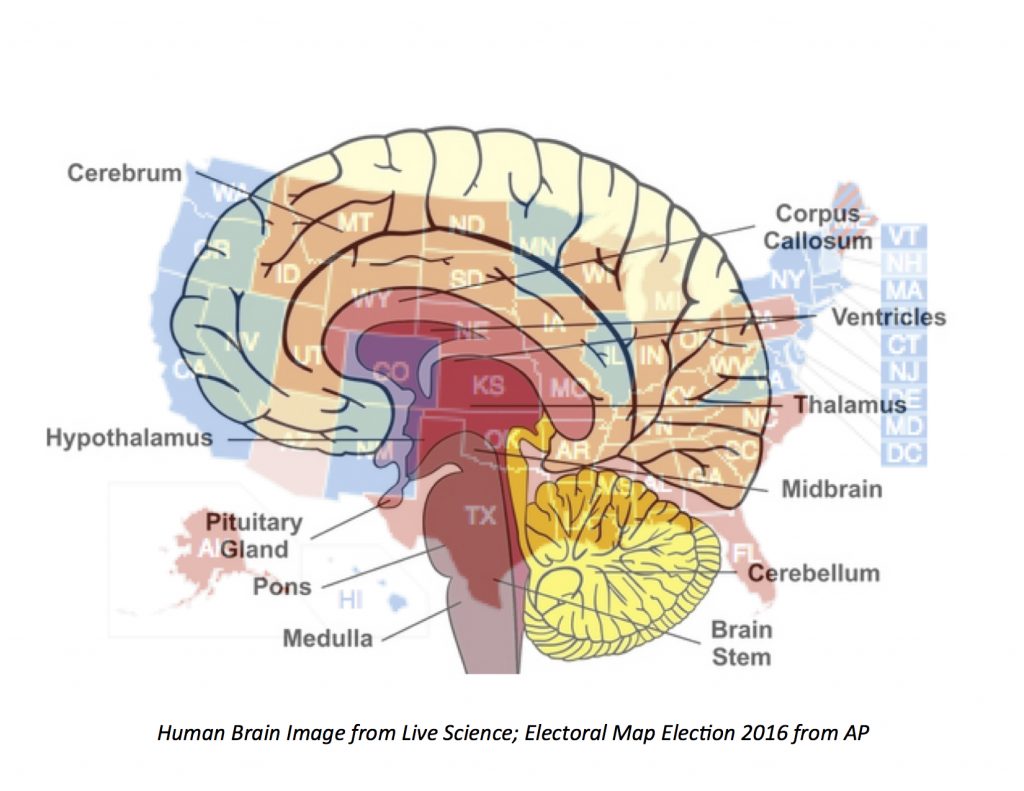 To my readers: sorry for being offline for a while – I was stressing over the elections – and apparently I am not alone. But the storm and fury of the election didn’t just cause us all to be stressed – one could argue that the brain’s stress response played a very large role in causing that storm and fury.
To my readers: sorry for being offline for a while – I was stressing over the elections – and apparently I am not alone. But the storm and fury of the election didn’t just cause us all to be stressed – one could argue that the brain’s stress response played a very large role in causing that storm and fury.In 1881, in his book called “American Nervousness, Its Causes and Consequences,” George M. Beard said: “The chief and primary cause of …[the] very rapid increase of nervousness is modern civilization, which is distinguished from the ancient by these five characteristics: steampower, the periodical press, the telegraph, the sciences, and the mental activity of women.”
Sound familiar? Just substitute the words automation, the internet, the media, and cultural change, for some of Beard’s words, and we see that nothing has changed in over a century. Had my father been alive, he would have said: “Plus ça change, plus ça rest la meme chose,” – “The more things change, the more they stay the same.”
So why is this? The brain’s stress response is a finely tuned instrument, set to trigger at the slightest change in the environment. Change and novelty are very potent stressors for all animals, even down to the lowliest fruit fly. This is a good thing, as without that stress response, when faced with a danger in a new environment, we would not have the energy to fight or flee; we would not survive. But we are living in an age of unprecedented change – change that is present, or feared in the future; change in our immediate surroundings, or distant from us; change that we cannot escape because it looms large through the internet. There is war and terrorism. There are jobs lost through automation – jobs that will never be replaced because machines and robots are doing them now. There is social change, with the influx of immigrants and clashes of cultures. There is poverty, violence and discrimination. And yes, the “mental activity of women” apparently continues to cause stress for some.
What does this have to do with the election? People said they wanted change, but what the science of stress tells us is that what they were really seeking was familiarity – with an older, simpler time. Familiarity is an effective way of reducing the stress of novelty and change. Of course we all long for a simpler time, when we imagine that none of these stressors existed, or at least that they were there in smaller amounts. So it is natural to search for a way to go back in time, to when the landscape of work and the people around were familiar. It is natural too, to place all our hopes on someone who promises to take us there. When Walt Disney designed his theme parks in the 1950s, he designed a Main Street to reflect the Main Street of his childhood. But if you look at pictures of his hometown’s Main Street, it didn’t look at all like Disneyland. There were certainly no pretty awnings and definitely no castle. It was the town he had dreamed of – a place that existed only in his imagination.
One very primal, almost reflexive way to lower the stress response is to act on it – express it, vocalize it, attack the perceived trigger, to try to get rid of it. That’s the “fight” part of the fight or flight response. This approach was unfortunately all too rampant in the lead-up to this election. But while this may feel good to the do-er in the moment, it is counter-productive in the longer term. It creates a vicious cycle that amplifies stress, especially if the perceived trigger fights back. And the stress is amplified even more if those attacks are launched relentlessly on a massive, society-wide scale, as they were throughout the election period.
But there are better ways of reducing stress – ways that don’t hurt others and ourselves, and which do ultimately get the desired result – a place of safety and comfort for all. How stressed one feels depends on the balance between the load of stress and the control we have over that stress. If you are in a high demand, high control situation, you feel stimulated – think pilot flying an airplane. In a high demand low control situation, you feel stressed – that’s the rest of us in the back of the plane when it gets bumpy. So, if the election results are making you stressed, one way to productively manage that stress is to do something to take control. Of course, you can never really be in control. But you can fool your brain into thinking that you have some control, and that will lower your stress response.
I have felt this way at a few critical times in my life when events so monumental stopped me dead in my tracks – 9/11 was one. When faced with stressful events that you can’t change, you can resolve to do whatever you can in your own sphere of expertise, to take control. If you are a teacher, teach; a builder, build; a driver, drive; a cook, cook; a healer, heal. That will give you a sense of control over the situation and doing so will lower that feeling of stress. I write and do medical research. I am already feeling less stressed just writing this, so thank you, dear readers, for helping me out!
One even better way to lower your stress response is to do those things that you do best, and do them for others. If enough of us apply our own special talents to doing good, then perhaps the cumulative good will have a chance of canceling out the bad, while lowering our collective stress in the process.
That may sound naïve, but it works. Love and compassion are actually more effective ways to counter the brain’s stress response, by activating all those positive brain hormones, nerve chemicals, and brain pathways, than is trying hard to reduce stress. When I asked the Dalai Lama whether he uses meditation to reduce stress, he shook his head. Stress, he said, was not a word in the Buddhist tradition. When I asked, why then does he meditate, he answered, compassion – love – it’s that simple.
The Dalai Lama is not the only spiritual leader who has preached this gospel. Having compassion for people on both sides – each struggling with their own stresses – change, job loss, new culture, loss of home or homeland, fear, discrimination, violence, poverty, and on and on – is one of the best ways to lower your stress response. By doing so, hopefully we will all find a new way forward, to work together to find solutions on common ground, to build instead of to tear down, and to do it together, with respect for the fears and stresses that motivate us all. That is what will make this country truly great again.
Maybe then we can all have our castles at the end of Main Street. After all, the United States was founded on these principles – that we all have certain unalienable Rights, and these include the pursuit of Happiness.
COANIQUEM – Safe Niños Part 2
On my third meeting with the students, a small core of three teams remained, each continuing the project through a second term. Each team presented their projects that had matured and were ready to take back to Chile to install. The first student, Alvin, presented the story and animal characters his team had created to help guide the children through the magic land through which they would be “flying” as they went on their healing journey. 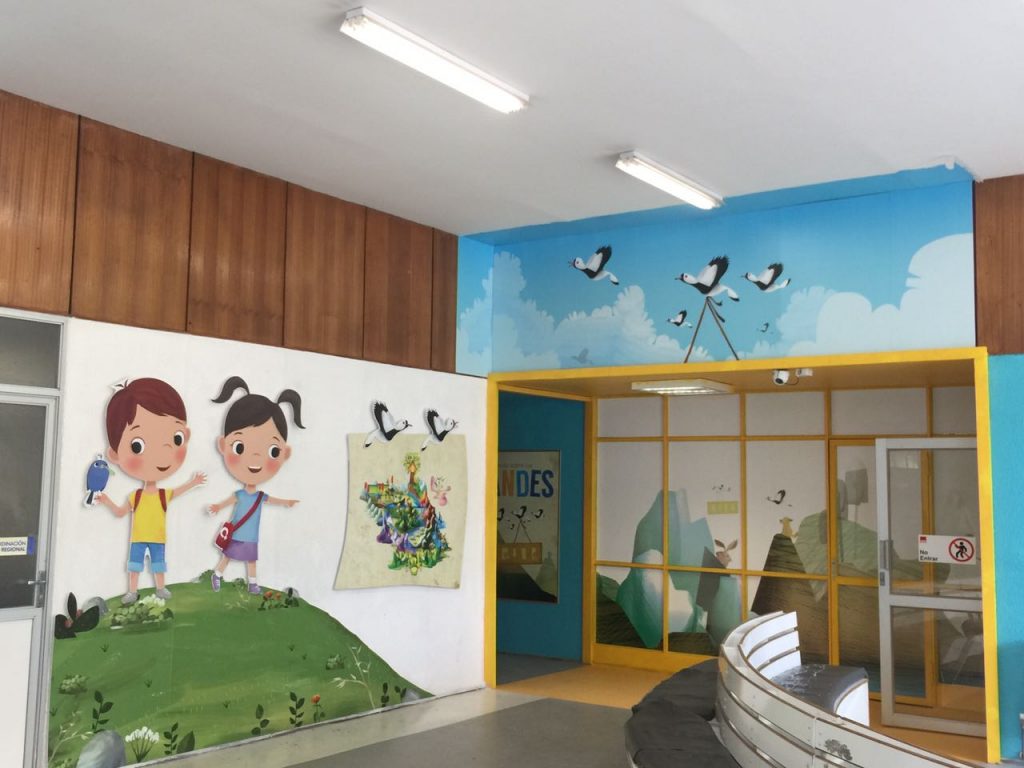 The land, complete with a colorful map that resembled a cross between Middle Earth and Candy Land, was, like Chile – long and narrow, flanked with whimsical mountains peopled by the trees and animals of Chile.
The land, complete with a colorful map that resembled a cross between Middle Earth and Candy Land, was, like Chile – long and narrow, flanked with whimsical mountains peopled by the trees and animals of Chile.  The waiting room was to be the entrance to this magical kingdom, and the doors leading to treatment rooms along the long hallways were to be decorated with charming animal characters inviting the young patients in. There was even a passport that the children and their families would receive when they arrived in the waiting room, to be stamped in every treatment room when they received their compression garments, physio- or occupational therapy.
The waiting room was to be the entrance to this magical kingdom, and the doors leading to treatment rooms along the long hallways were to be decorated with charming animal characters inviting the young patients in. There was even a passport that the children and their families would receive when they arrived in the waiting room, to be stamped in every treatment room when they received their compression garments, physio- or occupational therapy.
Then students Behnia and Anna presented their solution to motivate the teens, who had been returning to the clinic for years for multiple treatments: a “Teen Zone” flanked by mural-painted shipping containers that were already being used for storage on the site. The area would be covered with colorful sail shades and was made attractive to teens with a dance area and hammocks.
Finally, Nicholas and Dave presented their low and hi tech brightly colored “toys,” designed to help the children participate in physio- and occupational therapy treatments to increase mobility and activity, and reduce stress. The design challenge that they were solving was how to provide the therapists measureable feedback on the progress of treatment, while motiving the kids with musical and visual feedback.
It was a remarkable display, accomplished over a few short months. The passion of the students shone through. An added benefit: the project had inspired the staff, the patients, and their families with pride for COANIQUEM and its cutting edge treatments, giving them happiness and hope for healing, even before the projects were installed. Then, to top it off, one of the students – Alvin, won a grant to complete his project and fly back to Chile to install it, launching his career while doing good in the world. What better outcome could there be!
COANIQUEM – Safe Niños Part 1
It started out with informal phone calls from my daughter Penny, when she and her partner Dan began working on their latest project in South America – advising COANIQUEM, a children’s burn center in Santiago, Chile. COANIQUEM’s Founder and Director, Dr. Jorge Rojas had asked Designmatters, a United Nations NGO within Pasadena’s ArtCenter College of Design, to make the spaces less scary and more inviting for their patients.Designmatters’ Director Mariana Amatulo, turned to Penny and Dan, as lead faculty for such South American Pacific Rim projects, to spearhead the initiative. After several phone calls from Penny asking my advice, we decided to formalize the relationship, and I became an official advisor, to help them turn COANIQUEM into a healing space.
The burn center serves over eight thousand child burn patients per year from across all of South America. It is a monumental task, as more than 7 million children are burned per year in Latin America, over seven times the burn rate in the developed world. More like a small village than a hospital, COANIQUEM includes a long-term care clinic, surgical outpatient services, physiotherapy, occupational therapy, a school, a chapel, and housing for the long term patients.
The Designmatters teams – usually two to three faculty and ten to twelve ArtCenter students, work closely with the NGOs and communities they are serving, to identify their greatest needs, and come up with design solutions together. It is truly social entrepreneurship working with, not just for the people who will benefit. The COANIQUEM project was named “Safe Niños” – to continue the theme that their first project, “Safe Agua” had begun.
I gave my first lecture to the ArtCenter student group shortly after they had returned to LA from their first trip to Chile. They had lived on site at COANIQUEM for two weeks, staying in the same dormitories as the families and patients. They had spent their days talking with and observing the day-to-day activities of all the staff, the patients, and their families, to identify their greatest needs and wishes for improvements.
At that point the students had barely formed their small group teams, and some had only a vague idea of their plans of action. So our interaction was mostly didactic – I gave my PowerPoint presentation on “Healing Spaces,” outlining elements of place that can stress or calm. When I came to the slide of me in Disneyland, on my 2008 behind-the-scenes-tour when I was researching my book Healing Spaces, the students nearly leaped out of their seats and begged me to please, please get them a behind-the-scenes tour of Disneyland too! At first I laughed at the idea, but then figured it was worth a try.
The design issues at COANIQUEM were much the same as those with which Disney’s Imagineers dealt when designing the theme park: how to move people through a space without being there to guide them every step of the way, and at the same time bringing them from fear and anxiety to hope and happiness. COANIQUEM had an entrance, long hallways, and many buildings that needed to be made easier to navigate and less threatening to the kids.
As soon as I returned to Tucson, I e-mailed Bruce Vaughn who, as VP of Disney Imagineering had given me the tour in 2008. He had since risen to Chief Creative Officer of Disney Imagineering, and enthusiastically arranged the tour for the group. He, and all the Imagineers we met were happy to apply their skills and talents to training the next generation to do good in the world through design. 
It was wonderful to watch the students drink in every word, some taking notes, many taking pictures, and all seeing the Park through the eyes of burgeoning young design professionals.
To be continued….
The “Green Road”: Healing wounds of war with nature. Part 2
The first sign that I was getting close to the “Green Road” was a view of a grove of trees and a flock of geese staidly crossing the street nearby. The urban noises began to fade as sounds of crickets and birds gradually replaced them. It was like the “slow fades” between lands in a Disney theme park. Soon, I was surrounded by trees as I entered an entirely new world. 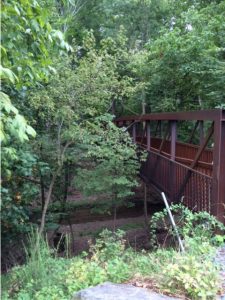 The gently sloping paved switchback path led to an old iron bridge across the Rock Creek. As I crossed the bridge over the pebbled lazy stream below, I could see deer grazing among the trees. The leaf-strewn path led to an open area where large granite rocks had been placed in a circle – inviting visitors to gather and share songs and stories. Farther on, beside the stream, was one of the signature large oak benches that the TKF Foundation places in all their gardens. There, visitors can contemplate in peace, or write their thoughts in a waterproof journal placed underneath the seat. Up on the steep hillside above the stream was a simple covered wooden structure, held by a low dry rock wall. A single large slatted wooden bench at its back, welcomed one to sit in quiet and remember loved ones lost in battle.
The gently sloping paved switchback path led to an old iron bridge across the Rock Creek. As I crossed the bridge over the pebbled lazy stream below, I could see deer grazing among the trees. The leaf-strewn path led to an open area where large granite rocks had been placed in a circle – inviting visitors to gather and share songs and stories. Farther on, beside the stream, was one of the signature large oak benches that the TKF Foundation places in all their gardens. There, visitors can contemplate in peace, or write their thoughts in a waterproof journal placed underneath the seat. Up on the steep hillside above the stream was a simple covered wooden structure, held by a low dry rock wall. A single large slatted wooden bench at its back, welcomed one to sit in quiet and remember loved ones lost in battle.
 The path led to a tiny wooden cabin whose roof shaded a wooden picnic bench with iron joints salvaged from the World War II battleship SS Diamond Head. A crowd of civilians and military personnel from the Army, Navy and Marines were gathered there, listening as the sweet voices of two women singing America the Beautiful filled the clearing. Photographers and TV camera crews stood behind the rows of people on folding chairs. After speeches and thank you’s from dignitaries, including Capt. Fred Foote, the Base Commander, Senator Barbara Mikulski, and the funding partners –The Institute on Integrative Health, and TKF’s Tom Stoner, the ribbon cutting officially opened the site (a green ribbon, of course!). We were then free to wander in the grove before retiring to the USO lounge for a barbeque lunch.
The path led to a tiny wooden cabin whose roof shaded a wooden picnic bench with iron joints salvaged from the World War II battleship SS Diamond Head. A crowd of civilians and military personnel from the Army, Navy and Marines were gathered there, listening as the sweet voices of two women singing America the Beautiful filled the clearing. Photographers and TV camera crews stood behind the rows of people on folding chairs. After speeches and thank you’s from dignitaries, including Capt. Fred Foote, the Base Commander, Senator Barbara Mikulski, and the funding partners –The Institute on Integrative Health, and TKF’s Tom Stoner, the ribbon cutting officially opened the site (a green ribbon, of course!). We were then free to wander in the grove before retiring to the USO lounge for a barbeque lunch.
I had wandered the grove myself on the Saturday before the event, picking pebbles by the stream, sitting on the benches listening to the forest sounds: the water swooshing over rocks, the wind in the trees, the birds’ cheeping, and the crunch of leaves underneath my feet.
It was indeed a healing place – a place of peace amidst the clatter and fray of the outside world; a place to heal the wounds of war.
The “Green Road”: Healing wounds of war with nature, Part 1
After the young service woman in full Navy camo cleared me for base access at the Visitor’s Entrance check-point, she pointed to the familiar white art deco tower of what used to be called the Bethesda Navy Hospital.“Just head up there, turn left and head straight to the USO. It’s a long walk,” she cautioned.
As I started my trek up the hill I felt anxious, not knowing exactly where I was going. But as soon as I saw a small printed sign by the edge of the road festooned with a green ribbon, I smiled. Finding my way to the site would be like a scavenger hunt!
I was at the Walter Reed National Military Medical Center military base in Bethesda, Maryland, for the opening of the “Green Road” Project. It had been 5 years in the making. The goals: to retrofit a branch of the Rock Creek that flows through the base, make it ADA accessible for wheelchairs and anyone with difficulty walking, and create a healing forest glen where wounded warriors and their families could gather and find respite while being treated at the many hospitals on base.
I had been involved in the project from the start, having advised the CEO and founder of the TKF Foundation and his Board on the most impactful way to dispose of the Foundation’s funds as they searched for a way to sunset it. Up until that time the Foundation had built hundreds of healing, sacred nature spaces throughout Maryland and the mid-Atlantic region. They wanted to use their remaining funds to build a smaller number of gardens that would have greater national impact. They had asked me, and a group of experts, to advise them on how to accomplish that.
I had been working with Capt. Fred Foote, a retired Navy doc, at the then Bethesda Naval Hospital. As he worked to bring holistic mind-body integrative treatments into the armamentarium of military medical care, he dreamed of creating a healing forest glen as a sanctuary for service personnel and their families. It was a no-brainer, I thought – put him together with TKF to do it. Building this nature sanctuary at the nation’s flagship medical center – the one where Presidents are treated – would be sure to have tremendous national impact.
As I picked my way along the base’s busy urban street, past the hospital’s main entrance, a continuous stream of trucks and cars passed by, leaving behind their smells of exhaust and diesel. Loud machinery noises filled the air – constant humming emanating from whole buildings filled with heating and air conditioning equipment for the base; jack-hammering and clangs of construction equipment. The sidewalk was sloped and there were many streets to cross. I couldn’t imagine how anyone in a wheel chair or on crutches could navigate this route without stress, twice daily to and from their living quarters to the hospital.
To be continued…
